What is kingdom Protista? Characteristics and Importance
Protists Definition
Kingdom Protista describes eukaryotic organisms that are not fungi, plants, or animals but that have similar characteristics to some or all of those kingdoms. Most protists are microscopic and single-celled, but some organisms within this kingdom are multicellular. Seaweeds, for example, are large multicellular organisms within the Protista kingdom.
Many protists also form colonies. However, these colonies are not technically multicellular organisms. They are simply large groups of single-celled protists that form groups.
Like eukaryotes, protists contain highly specialized membrane-bound organelles such as the endoplasmic reticulum, the Golgi body, and the mitochondria. Some protists also contain chloroplasts.
“The simplest definition of protists can be laid down as all living things that are not plants, animals, or fungi,” says Alastair Simpson, professor at the Department of Biology at the University of Dalhousie.
Three general types of protists
We can define and classify a protists organism on the basis its similarity to a particular kingdom. This leads to three general classes of protists:
A) Animal like Protists i.e. protozaons

- Protozoa are mainly unicellular.
- They generally have the characteristics related with animals, such as mobility and heterotrophy.
- Most protozoa are too small to be seen with the naked eye and are best seen under a microscope.
- They live in aquatic environment.
- Protozoa are traditionally divided according to how they move – their means of transport.
- Some protozoa have the ability to form a cyst to protect themselves from harsh conditions.
B) Plant like protists i.e. algae
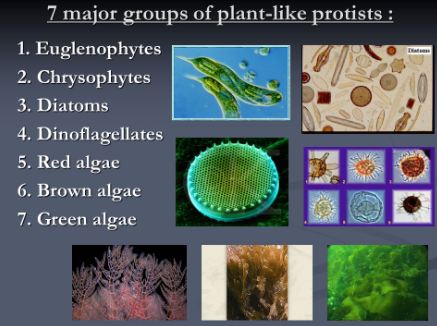
- Plants like protists are autotrophic, which means they make their own food. Almost all plant protists are a type of algae. They have chlorophyll and are photosynthetic.
- A very common type of plant-like protists are diatoms which are a type of golden algae. The most common type of green algae we found is spirogyra. Spirogyra covers a large part of the bottom of the pond.
- Examples of Algae are
- Green algae (Chlorophyta)
- Euglenophyta (Euglenoids)
- Golden-brown algae and Diatoms (Chrysophyta)
- Fire algae (Pyrrophyta)
- Red algae (Rhodophyta)
- Yellow-green algae (Xanthophyta)
- Brown algae (Paeophyta)
C) Fungus like protists i.e slime molds and water molds
There are two major types of fungus–like protists. These are water molds and slime molds.
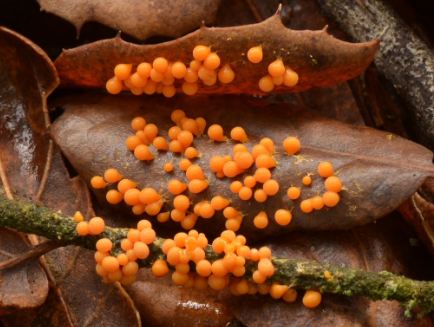
Myxomycetes, or slime molds
- Mycetozoa or Myxogastria, are a group of amoeboid protists, considered for many years as a special group of fungi.
- They are microscopic, phagotrophic, non-pathogenic bacteriophors that help decompose plant debris. Its life cycle has amoeboid, mobile, trophic stages, either single-celled (mixamoebas or swarm cells) or multinucleated (plasmodia), and a reproductive stage with spores generated by a complex non-mobile fruiting body.
- They are found in all terrestrial ecosystems, and around 1000 species are known worldwide.
- Myxomycetes, also called plasmodial slime molds, dicytosteroids, cellular slime molds, or “social amoebas,” and protostelids are part of a group now called Amoebozoa.
Oomycetes or Water molds

- Oomycetes, also known as “Water molds”, are a group of organisms that include some of the most devastating pathogens of plants, reproduce by spores.
- The diseases they cause in plants include root rot, leaf blight, seedling blight, wetting and downy mildew. Most notorious diseases like late blight of the potato, powdery mildew of the vine, sudden death of the oak, and root rot and soybean stalks are also caused by water molds.
- Oomycetes were considered by phytopathologists as lower fungi but it is now clear that this group of organisms is not related to real fungi.
What are the characteristics of protists?
1- Protists Diversity
These are most diversified organisms on earth. In short, protists are a very diverse group of organisms, just like the eukaryotic cells that make up protists.
- Some are more like plants, others are more like animals, and others are more like fungi. For example Animal like are protozoans, Plant like are algae and Fungus like are slime molds and water molds
- Some are unicellular (e.g.yeast), while others are multicellular ( e.g.Kelps in ocean)
- Some protists are photosynthetic (e.g.Algae), which means that, like plants, they can convert energy from sunlight into foods like sugar. But some are perfectly heterotrophic for example, amoebas, paramecia, sporozoans, water molds etc.
- Most, but not all, cannot be seen without a microscope.
- Some protists reproduce asexually, while others reproduce sexually.
- Single cell protists: There are more than 100,000 different species of diatoms. These protists are single-celled algae (or plant-like protists) and come in numerous different forms. These range from cylindrical to triangular to oval and to stars shapes.
2- Cellular structure of protists
- Cell membrane: All protist cells are surrounded by a cell membrane, which is a fluid, protective layer that helps separate the protist cell from its external environment, keeping everything inside safe and sound.
- Eye Spot: Some protists even have an eye spot, which is an organelle that helps them detect light, so they can head into or out of the light as they wish.
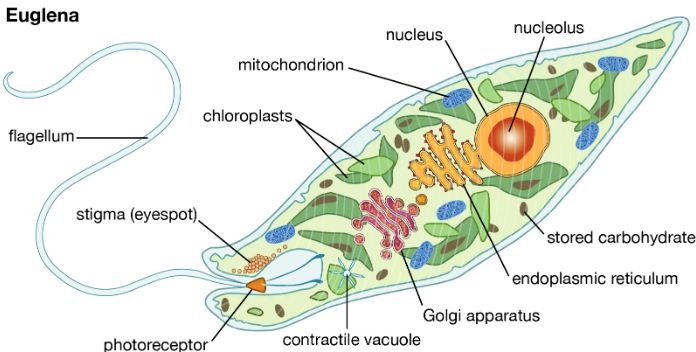
Cell structure of model protist, Euglena - Nucleus: Like all eukaryotes, protists have a distinct central structure called the nucleus that accommodates the genetic content of single cells. This nucleus protects the DNA of the protist, which is the model or code that executes all the functions of the protist cell.
- Organelles: Protist cells, like other eukaryotic cells, have tiny organelles or organs that do a different job within the cell. Ribosomes are the organelles responsible for synthesizing all the proteins that the protist will need, while the endoplasmic reticulum and the Golgi apparatus help to fold and classify these proteins. Protists also have mitochondria, which are the organelles responsible for converting food into energy that the cell can use.
- Plastids: The photosynthesis protists, such as different types of algae, contain plastids. These organelles are photosynthesis centers (the process that involves collecting sunlight to form nutrients in the form of carbohydrates).
- Hydrogenosome: eSome protists living in non-oxygen conditions use organelles called hydrogenosome, which is a modified form of mitochondria – to produce part of the cell’s energy.
- Alveolates: Alveolates are protists that have small membranous sacs, called alveoli, that lie just below their cell membranes. The exact function of the alveoli is unknown, but they can help with protection and thermo regulation.
- Dinoflagellates: Dinoflagellates are a group of alveolates that have two very interesting characteristics. They are able to glow in the dark, a phenomenon known as bioluminescence. When their populations experience sudden growth, dinoflagellates may also be responsible for what we call red tide, or the reddish / brown water that you may see on shorelines from time to time. Dinoflagellates are often spherical in shape, generally single-celled and, as the name suggests, also have flagella.
- Plasmodium: Less spherical and more oblong, plasmodium cells also contain alveoli. These protists, when transferred by certain mosquitoes, can cause malaria.
3- Protista Nutrition
: A) Nutrition in Animal like Protists
Animal protists are heterotrophs. This means that in order to obtain food and nutrition, these protists must eat / ingest food from their environment. They can do this in various ways.
Endocytosis, also called phagocytosis, is the most common method of heterotrophic nutrition in protists. This is when protists like animals physically swallow their prey. Amoebas, for example, are animal-like protists that engulf their prey and break it down inside their cells to get their nutrition. These types of protists are also called phagotrophs.
Other animal-like protists are filter feeders. They often use their flagella like structure to beat back and forth and create a flow or current around them to filter and absorb food from their surroundings. This type of heterotroph is also called an osmotroph, which means they absorb food to eat from the environment instead of wrapping them whole like a phagotroph.
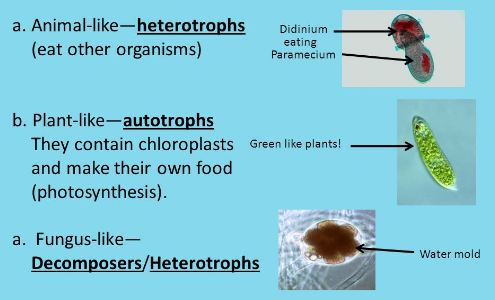
B) Nutrition in plant like Protists
Plant protists are autotrophs. This means they create their own food without having to eat or gobble up other organic organisms / materials in the environment. Plant-like protists have chloroplasts in their cells to photosynthesize to convert sunlight into food (also known as glucose).
Examples of common plant-like photosynthetic protists include microscopic algae as well as huge multicellular algae such as seaweed.
C) Nutrition in fungus like Protists
Fungus like protists are also called mold. The two main types of fungus-like protists can be divided into water molds and slime molds.
These types of protists are absrbtive heterotrophs. This means that they absorb their food (nutrients and organic materials) from space, the environment and the organisms that surround them.
D) A unique case: Mixotrophs
Some rare protists can obtain both autotrophic and heterotrophic food. These protists are known as mixotrophic as they can consume organic organisms / materials and photosynthesize for food: it is a “mix” of autotrophic and heterotrophic ability. For example nanoflagellates like Prymnesium parvum or Karlodinium micrum are Mixotrophs.
Reproduction in Protists
Protists have developed a multitude of sexual adaptations to suit their environments and characteristics. The type of reproduction used by protists is influenced by their life cycles. However, most protists use some combination of sexual and asexual reproduction, although some only use one exclusively.
Asexual reproduction
Protists reproduce asexually by budding and binary fission.
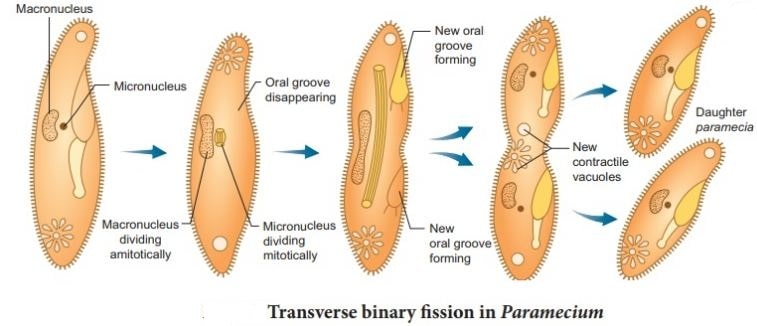
- Binary fission is a form of multiple fission and is also considered the most typical form of reproduction in the protist realm.
- Budding occurs when asexual reproduction produces a bud, a child nucleus, which then develops into its own structure.
- Binary fission is an unsustainable form of asexual reproduction that eventually needs a form of sexual reproduction called conjugation. Conjugation is the exchange of genetic material between two protists to prevent death caused by binary fission more than several hundred times.
Sexual reproduction
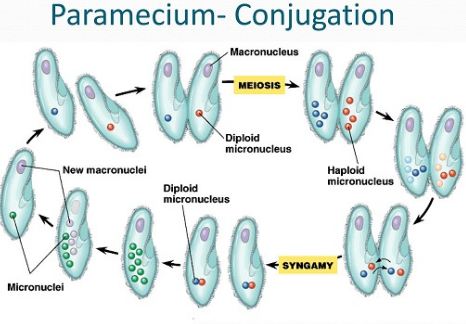
- Syngamy: Protists reproduce sexually through syngamy, which is conjugation and an alternation of generations. In syngamy, two gametes, reproductive cells with half the required genetic material, combine to form a zygote, a fertilized egg. Singamia occurs in slime molds, green algae, and similar organisms.
- Alternating generations: It is essential for plants, but it is also used by protists for sexual reproduction. It requires two alternate generations, sporophytes and gametophytes, which work together to reproduce. Zoospores, created by sporophytes, produce male and female gametophytes, which combine eggs and sperm, producing a new sporophyte to restart the cycle.
Importance of Protists
- Humans couldn’t live on Earth if it weren’t for protists. Why? The Protists also play an important role in the environment. According to a 2009 article on the Life Sciences Encyclopedia, algae performs close to 50% of all photosynthesis on Earth’s surface, and protists also help in recycling nutrients through ecosystems, according to a general publication. 2002 in the journal ACTA Protozoologica.
- Protists break down and recycle the nutrients that humans need to live. All protists make up a large part of the food chain.
- Many protists are also commonly used in medical research. For example, drugs made with protists are used in the treatment of high blood pressure, digestion problems, ulcers, and arthritis.
- Other protists are used in scientific studies. For example, slime molds (including D. discoideum, a protist that lives in the soil) are used to analyze chemical signals in cells.
- Protists are also valuable in the industry. Look at the back of a milk carton. Chances are you’ll see carrageenan, which is extracted from red algae. This is used to make puddings and solid ice creams (Figure below).
- Chemicals from other types of algae are used to produce many types of plastics.
Read more about protists
